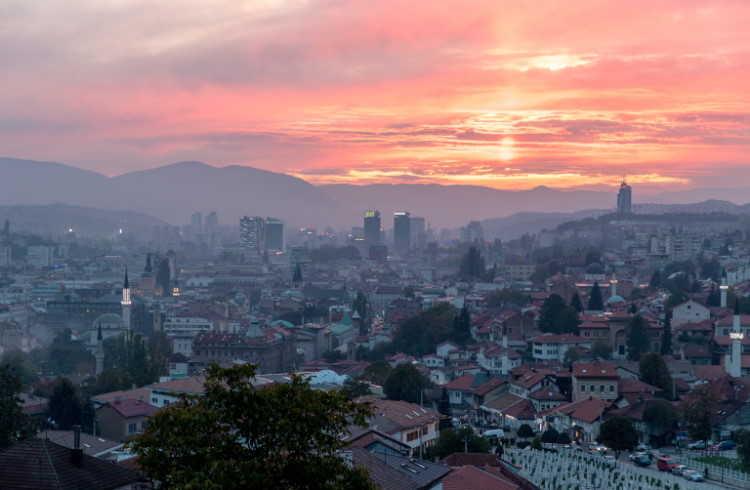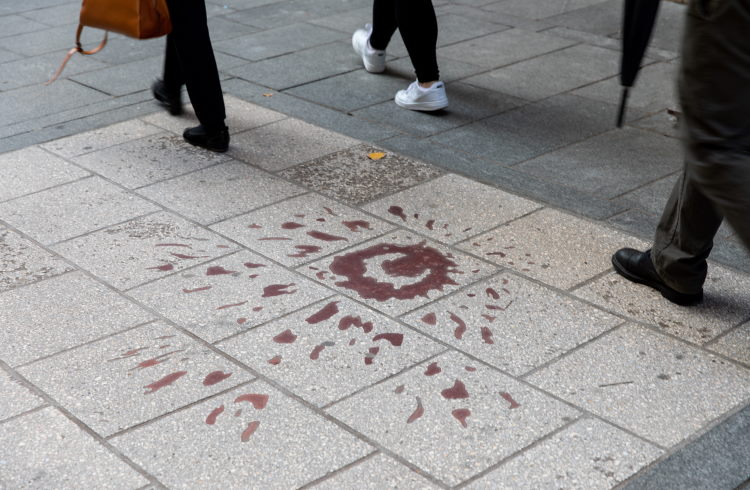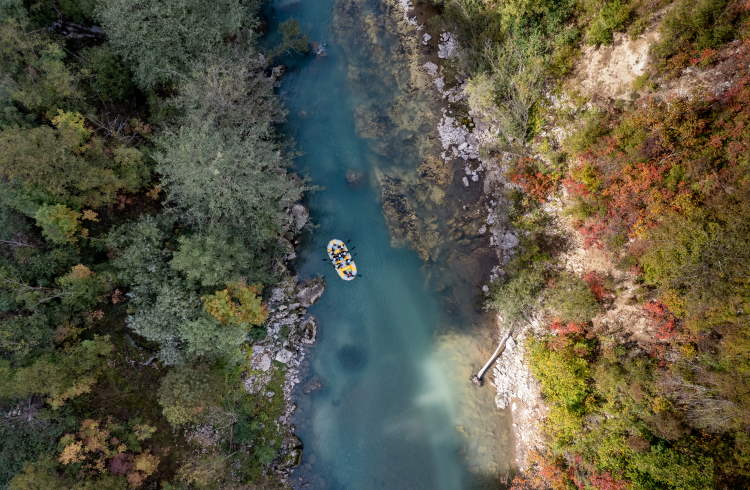Visiting Bosnia & Herzegovina 30 Years After the War
Three decades after the start of the Bosnian war, Christine Retschlag explores the beauty, complicated history, and enduring spirit of Bosnia and Herzegovina through the eyes of the locals.
Shares
 Photo © Annapurna Mellor, Intrepid Travel
Photo © Annapurna Mellor, Intrepid Travel
The omnipresent Adele is crooning through the stereo how she set fire to the rain, but around this Bosnian Muslim dinner table, it’s more a case of extinguishing the flames of the past.
I’m in a house built from scrap metal, high on the hill overlooking the lights of Sarajevo, as a guest of locals Mustafa and Mersiha, whose business – Bosnian Cooking Lessons – also stages hosted dinners.
Here, you dine on organic food including their own plum brandy and the traditional burek, Bosnian pita bread made from flour, salt, sunflower oil, and lukewarm water, while wrapping your mouth around the alphabet soup of consonants this language commands.
Mersiha, who was nine when the Bosnian war began in 1992, stretches the dough like an accordion player and explains how her mother tried to keep her entertained during the 3.5-year attack on Sarajevo by teaching her to cook.
“It was a lot of pressure because if you got it wrong, there was no trying again as we didn’t have enough food,” she says.

For Mustafa, who was 13 at the time, it was the years spent underground which he found most challenging.
“It wasn’t the bombs or bullets but the darkness. Everything underground was pitch black. The light was something we used to dream about,” he says. “One night, I saw one-third of the city lights come back on and that’s when I knew the war was really over.”
- A tour designed to boost the local economy
- History, scenery, adventure, and wildlife in Bosnia and Herzegovina
A tour designed to boost the local economy
In May 2023, Intrepid Travel will launch its first tour dedicated solely to Bosnia and Herzegovina, made possible by a three-pronged partnership forged two years ago with USAID’s Developing Sustainable Tourism in Bosnia and Herzegovina (Turizam) program and the Global Travel and Tourism Resilience Council.
The trip is part of a five-year, US $20 million project which aims to enhance the quality and diversity of tourism products, create new job opportunities, boost employment, encourage the participation of women in the workforce, and drive economic growth.
In 2019, the country had the third-highest tourism growth rate in the world, and the sector contributed more than US $1 billion to the economy. In 2020, however, the COVID-19 pandemic decreased tourism revenues by more than 85 percent and hampered the sector’s development.
This eight-day Bosnia & Herzegovina Expedition is designed to showcase the best of Bosnia, including nature, soft adventure, war history, and local characters such as Mustafa and Mersiha and the city’s only woman coppersmith, Nermina Alic.

As a former newspaper journalist, I watched the nightly Bosnia bombings and Sarajevo under siege 30 years ago from the safety of Australia, so the invitation to come to visit the country on a preview tour is too great to resist.
The tour begins on the still-scarred streets of the Bosnian capital where I encounter the Sarajevo “rose” – a deep imprint left by mortar shells and painted red by locals – to mark the spot where around 100 civilians were killed on two separate occasions, and the Tunnel of Hope – a hidden pipeline dug to connect besieged Sarajevo with the outside world.

History, scenery, adventure, and wildlife in Bosnia and Herzegovina
But there’s much more than war to beautiful Bosnia. We wind through lush countryside painted in autumnal rusts, snake past rivers and into Jajce – the capital of medieval Bosnian kings – renowned for its inner-city 72ft (22m) waterfall and sparkling lakes reminiscent of Switzerland.
In the back of a jeep on an off-road safari we encounter Bosnia’s wild horses who roam free as part of a herd of 1,000 at the base of the Cincar Mountain, before feasting on meats, cheeses, and beer in a mountain hut.
Cobbled streets pave the way through magical Mostar, bustling with street stalls and stairs which lead to the iconic one-arc Mostar Bridge, while an inconspicuous road takes us to former Communist leader Tito’s secret nuclear bunker in which 80 percent of the items – placed to house 350 in the event of an attack – remain. Intriguingly, it’s now also a contemporary art gallery.
Towards the end of this eight-day journey, there are opportunities to go white-water rafting down the Neretva River, and explore canyons and waterfalls, before returning to Sarajevo to take a cable car to the Dinaric Alps where the successful Sarajevo Winter Olympics were held in 1984 and are considered a golden era in the city’s history.

Not part of this tour, but a must-do while in Sarajevo, is the War Childhood Museum which opened in 2017 and is the only one of its kind in the world which tells the experience of war through the eyes of children.
Intrepid Tour Leader Muhamed Vlajcic was 10 when the war started.
“For 3.5 years Sarajevo lived through hell on earth. 300,000 people lived without food and electricity, every day in continuous terror,” he says.
“We pretended we had a life but trust me, it wasn’t a life.”
Yet, Muhamed reminds us that art, school, clubs, pubs, bars, and more than 1,000 theater shows continued in underground basements throughout the siege.
“The spirit of Sarajevo was never killed,” he says.
USAID Developing Sustainable Tourism in Bosnia and Herzegovina Chief of Party Ibrahim Osta says the best thing travelers can do to help the continuing recovery is to come to the country, meet locals and support the economy.
“Tourism has the power to create livelihoods for people in areas that no single industry can. With tourism you leave money everywhere [you] go,” he says.
“It’s authentic, it has zero negative impact, and you have a true Bosnian experience.”
Trip notes
Intrepid’s new 8-day Bosnia & Herzegovina Expedition will launch in May 2023 with five departures scheduled. The tour starts from AUD $1,995.
Simple and flexible travel insurance
You can buy at home or while traveling, and claim online from anywhere in the world. With 150+ adventure activities covered and 24/7 emergency assistance.
Get a quote
No Comments